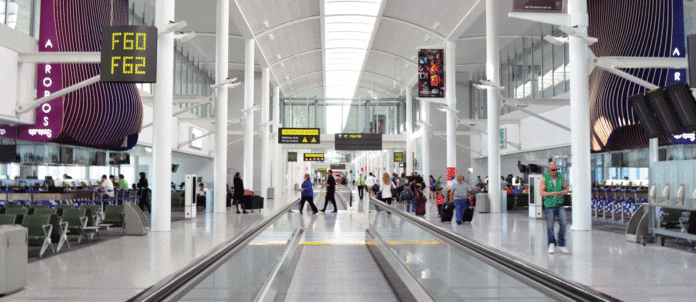By: Ian Harrison
[dropcap size=big]M[/dropcap]ark McEwan used to avoid the restaurants at Canada’s busiest airport. “Pearson was always famous for no food to really bad food. I barely ate there,” says the Top Chef Canada judge, whose restaurant assets in Toronto include North 44, Bymark and Fabbrica.
McEwan is a major player in a gambit by the not-for-profit Greater Toronto Airports Authority (GTAA), which manages, operates and maintains Toronto Pearson International Airport and is retooling its foodservice landscape. With consulting on two concepts, the Fetta Panini Bar and Nobel Burger Bar under his belt, one of McEwan’s hurdles is to alter dismally low expectations. There are signs of a shift. “We did $20,000 in sales one day at Nobel. This is at a burger bar in an airport. It’s remarkable.”
As part of the GTAA’s phased upgrade, McEwan’s company also offers catering services, preparing and delivering up to 2,500 food units (think salads, sandwiches) to 10 restaurants managed by the New York-based OTG, one of three primary foodservice operators at Pearson. The end result is a new spinoff, of sorts, for the Toronto-based McEwan Group. “It’s [like] a new business,” begins McEwan, explaining how the company’s duties at the airport expand beyond foodservice to include navigating customs, expediting, packaging, labelling, costing out, compartmentalizing units and creating retail goods.
OTG, the firm that recruited McEwan — and others such as chef Rocco Agostino, sommelier John Szabo and baker Devin Connell — is a relative upstart in the suddenly sexy airport foodservices space, having forged chef partnerships at New York’s LaGuardia and JFK. Rick Blatstein, CEO, is a former restaurant and nightclub owner who asserts that his company delivers
“restaurants inside airports,” rather than airport restaurants. And, OTG claims its close to $11 per patron spend leads the industry in North America.
The chef-driven approach is deliberate. “We believe we can have great restaurants in airports,” explains Sean Aziz, director of Communications, OTG. “We work with chefs who understand their market. That insight allows us to create concepts that
are relevant.”
The OTG blueprint seems radical on the surface: upcycle wasteful terminal space into a profit generator with whiz-bang designs and Wi-Fi-enabled iPads, which display menus in 20 different languages and allow customers to order a glass of Pinot Noir with the swipe of a finger.
The suggestion that airports can, and should, serve good food evokes a bygone age when some of the best restaurants in the U.S. were in the likes of Chicago O’Hare and LAX. “Good food enhances the customer experience,” declares Janine Gervais, the associate director of the Retail and Food Programs at the GTAA. “In 2010 we took a long hard look at the retail and foodservices landscape at Pearson. It was lacklustre. So we set out to define a strategy to make the airport a premier gateway.” In the final analysis, no single airport served as a prototype for Pearson. Gervais contends that it was a matter of tailoring best practices to the Toronto market.
The decision to take those culinary ideas to the airport’s two Terminals (1 and 3) led to a new partnership with OTG and a reboot with two veteran primary operators. “HMSHost and SSP [Canada] have been with us for decades,” explains Gervais, of the companies based in Bethesda, Md. and Surrey, U.K., respectively. “They’ve evolved. The GTAA’s decision to continue with them was based on sitting down and talking about where we wanted to go, where they were at that point in the contract and then working to deliver the vision together.”
The GTAA’s primary goal was to generate more energy and buzz for the airport’s restaurants. HMSHost, OTG and SSP led the charge to identify key local chefs.
The entire Pearson foodservice upgrade, which began in 2011, and is slated to continue into 2016, already features almost 30 new restaurants, representing all segments. Just to get a taste of what’s on offer, there’s Acer, a modern Japanese restaurant by chef Guy Rubino and from OTG; Boccone Trattoria Veloce, a trattoria and Boccone Pronto, its quick-serve counterpart from SSP Canada in partnership with chef Massimo Capra; and Asian Kitchen by Susur Lee, a new addition from HMSHost this summer.
HMSHost, with a foothold in more than 100 airports around the globe, and annual sales in excess of $2.7 billion, had an existing partnership with Roger Mooking. So, the TV host and cookbook author consulted on menu improvements and helped with enlistment. One of the first calls was to the founder of Caplansky’s Delicatessen.
The deli’s owner, Zane Caplansky, and HMSHost expect the two Caplansky’s Delis at Pearson — the first of which opened thissummer — to do four times the volume as the original College Street location in Toronto. “I had wanted to look at franchising and growing my business. This is an ideal environment,” says Caplansky. “HMSHost is an incredible international franchisee. Some of the biggest brands trust them, and we have a built-in market at the airport. It was a wonderful win-win opportunity. We’re making the vast majority of the food the same as on College Street. The pricing is the same as well.”
The HMSHost executive behind the Pearson partnerships with Caplansky and other big names such as Lynn Crawford, Susur Lee, Mohammed Fakih and John Placko is Karen Grezner. The company’s director of Restaurant Portfolio notes
that it requires effort and persistence to convince high-profile chefs to license their names. Natural concerns about quality
dilution, procurement, supply-chain management and personnel require immediate assuagement.
“None of [the chefs HMSHost enlisted] were promoting their restaurants to be franchised and run by someone else,” notes Grezner. “And here I am saying we want to license their brand at Pearson. It’s like letting go of their baby. So there is trepidation. They have to have the confidence that it’s not just fast-food we’re doing and that behind the scenes we have a full kitchen with real chefs and a real level of skill — because every one of them has their name on the door and on the menus.”
And, while the approximately dozen chef consultants involved in the Pearson revamp will confront similar concerns, not all will be as hands-on as Caplansky. And that concerns prominent food writers in Canada, such as Toronto restaurant critic Chris Nutall-Smith. After several visits to the airport, The Globe and Mail columnist reserved his harshest criticism for OTG. “The initial promise from OTG was enormous. A year later I went and the chef’s faces and names were nowhere to be found. There are no real kitchens, because the terminal’s ceilings are so high, the company couldn’t install commercial exhaust systems. The prices are high, and the iPad ordering system is awful. They try to upsell you every time. You quickly realize the iPads are there, because they don’t want to hire staff.”
OTG has responded to those concerns. “The traditional restaurant environment is inefficient at airports, where time-management is everything,” says OTG’s Aziz. He adds: “The potential lack of human interaction was a major question we had [with the iPad deployment]. But it’s been the opposite.”
Most pointed, however, was this comment from a Nuttall-Smith column in March: “Two years ago, OTG management’s Michael Coury told me: ‘Some of your best restaurants downtown will now be in your airport.’ From what I tasted and experienced, that is not yet even close to being
the case.”
“We respect all feedback,” responds Aziz. “The great thing about our concepts is that, because we own and operate our restaurants, we can make changes on the fly.”
How deeply star chefs dig in at Pearson may be a key factor in whether critics, and customers, embrace the airport’s metamorphosis. “Each operator comes at it differently,” says the GTAA’s Gervais. “OTG hires chefs to design menus. With SSP, a chef like Massimo Capra is here very often. I personally have seen him on the line. As far as the new restaurants from HMSHost chefs, like Lynn Crawford and Susur Lee, we’ll see how they evolve.”
Overall, although the cost of the entire Pearson revitalization hasn’t been disclosed, Gervais is optimistic the foodservice turnabout will be a success. “Toronto Pearson has seen a 26-per-cent increase in sales across the board and a 15-per-cent to 63-per-cent increase in the actual number of guest transactions per new or redeveloped retail location. I am very pleased with the evolution of our program. The opportunity to enjoy a meal at an Italian restaurant with nice wine, or conversely, enjoy Subway or A&W is wonderful and demonstrates variety and diversity. And we’re just 60 per cent of the way there. Most of Terminal 3 will be redeveloped over the next year. By the time we hit 100 per cent of program turnover, lease renewals will start to come up and we will be working to reinvent our program to meet the needs of the next generation of passengers.”




![Redberry Restaurants Becomes Canada’s Area Director for Jersey Mike’s Subs Expansion Redberry Jersey Mike’s Subs - Paul Pascal (left), director of Operations, and Stephen Scarrow (right), senior Marketing manager]](https://www.foodserviceandhospitality.com/wp-content/uploads/2024/04/Redberry-Appointments-218x150.jpg)













